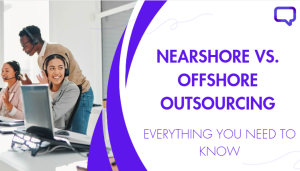Have you outsourced any part of your business to a call center? How do you know you’re getting the proper results from spending all that $$$?
Call centers are hectic.
There is no such thing as an easy day at a call center.
Even call center managers may lose sight of the bigger picture. So if you run a call center of your own, or you have outsourced to one, read on to find out how you can track the performance so you know you’re getting the most out of the call center.
We’ll be looking at call center KPIs – which seem endless! But fret not. Here are 11 of those KPIs you should watch closely.
- Customer Satisfaction Score (CSAT)
- Net Promoter Score (NPS)
- First Call Resolution (FCR)
- First Response Time (FRT)
- Percentage of Calls Blocked
- Call Abandonment Rate
- Average Speed of Answer (ASA)
- Average Time in Queue
- Average Handle Time (AHT)
- Customer Effort Score (CES)
- Customer Churn Rate (CCR)
But first…what are KPIs?
What is Call Center KPI?
A call center KPI (Key Performance Indicator) is a way to measure how well a call center is performing. Think of it like a scorecard that tracks important numbers to see if things are running smoothly.
For example, you might want to know how quickly calls are answered, how many issues are solved in the first call, or how happy customers are with the service. These are all call center KPIs.
If you run a call center, KPIs help you understand where your team is doing well and where they need to improve. For those outsourcing to a call center, KPIs are your way of checking if you’re getting your money’s worth. It shows if the service you’re paying for is actually delivering good results.
In simple terms, KPIs help everyone stay on the same page. You can easily see what’s working and what’s not, so you can make changes if needed.
Now that’s out of the way, let’s look at 11 different KPIs for call centers you should track.
1. Customer Satisfaction Score (CSAT)
Customer Satisfaction Score, or CSAT, is one of the most important KPIs in a call center. It tells you how happy customers are with the service they received.
Here’s how it works:
CSAT measures the customer’s happiness right after they’ve interacted with your call center.
Did the agent solve their problem?
Were they polite?
Did the customer leave feeling satisfied?
CSAT gives you these answers.
How to calculate CSAT?
It’s simple. After the call, you ask the customer to rate their experience on a scale. A common way to do this is to ask something like: “On a scale of 1 to 10, how satisfied are you with our service?” You can also use a simple yes or no question: “Were you satisfied with your experience?”
Net Promoter Score (NPS)
Net Promoter Score, or NPS, measures how likely your customers are to recommend your service to others. It’s kind of like a loyalty meter.
Here’s how it works:
After interacting with your call center, customers are asked one key question:
“On a scale of 0 to 10, how likely are you to recommend our service to a friend or colleague?”
Based on their response, customers are classified into three categories:
- Promoters (9-10): These are your happiest customers. They had a great experience and are likely to recommend your service to others. They’re your brand ambassadors.
- Passives (7-8): These customers are satisfied but not overly enthusiastic. They might not talk negatively about you, but they aren’t going out of their way to recommend your service either.
- Detractors (0-6): Unfortunately, these customers are not happy. They’re unlikely to recommend your service and might even discourage others from using it.
To calculate NPS:
First Call Resolution (FCR)
First Call Resolution (FCR) is one of the most important KPIs for any call center. It measures whether a customer’s issue is resolved during their first call without the need for follow-ups.
It’s all about convenience. They want their problems solved quickly, in one call, without needing to call back multiple times.
Trust me, customers HATE calling back for the same problems.
A high FCR rate means customers are getting the help they need right away, leading to better satisfaction.
A “good” FCR rate varies by industry, but anything around 70-79% is generally considered strong. The goal is to keep improving this rate by giving agents the tools and training they need to solve customer issues on the first go.
To calculate the FCR rate:
First Response Time (FRT)
First Response Time (FRT) is like the first impression a customer gets of your call center. It measures how long a customer has to wait before an agent attends to their call. Think of it as the “hello” moment – customers want that warm welcome right when they reach out for help.
Imagine you’re a customer reaching out for assistance.
What would you hope for? A quick response, right? I definitely would want that.
That’s exactly what low FRT aims to provide.
Percentage of Calls Blocked
Okay, this is a weird KPI for a call center. You might be asking: Isn’t the whole purpose of a call center to accept calls?
Not really.
Spam callers are everywhere and even call centers are not immune to them. This is why many call centers use software like Hiya or Dialpad to keep these spam callers at bay.
But why?
Call centers can only accommodate a certain number of active calls at one time. These spam calls just take up those slots, leaving customers like us hanging. After all, there is nothing less frustrating than waiting for minutes or even hours with customer support – only to hang up.
If a call center has a high Percentage of Calls Blocked statistic, it is likely due to two reasons:
- The call center is understaffed. The team gets more calls than they can handle, leading to skipped calls.
- The call center is targeted by spam callers who take up spots for actual people who need help.
If you’ve outsourced to a call center, make sure you keep an eye out for this metric as it directly affects Customer Satisfaction Score (CSAT).
Call Abandonment Rate
Have you ever contacted customer support only to hang up early for one reason or another? I mean..how’s that even a question: Of course you have.
The percentage of people who do that is essentially the call abandonment rate.
There could be a number of reasons why people hang up the call even before reaching an agent:
- Long wait times
- Lack of information
- Weird menu navigation
Abandoned calls happen. It’s not always a call center’s or your customers’ fault. It’s a good idea to measure the call abandonment rate and dive into what’s causing them. It’s a good idea to use conversational IVR software like Sprinklr so they don’t have to wait and listen to the annoying dial tone for too long!
Average Speed of Answer (ASA)
Nobody likes waiting. Especially when you’re on the phone, listening to the same elevator music over and over again.
The Average Speed of Answer (ASA) is a call center KPI that measures how long it takes for an agent to pick up after a customer has been placed on hold. It’s basically the waiting time your customers experience before getting the help they need.
Why does it matter?
Well, a shorter ASA means happier customers. A longer one? Frustration. The quicker your call center agents can answer, the better it is for the overall customer experience.
Factors that can affect ASA include:
- The number of agents available at any given time
- The complexity of the customer issue
- The time of day or season (like the holiday rush)
Keeping ASA low is a win for both you and your customers. Nobody likes to be kept waiting, and lowering this metric can boost customer satisfaction in no time. Try using workforce management tools like Five9 or Talkdesk to make sure you have enough agents available to keep those wait times down!
Average Time in Queue
We’ve all been there. You call customer support, and before you even speak to a human, you’re stuck waiting… and waiting… and waiting.
The Average Time in Queue tells you how long customers are left hanging in that dreaded limbo before they actually reach an agent. It’s the time spent waiting after navigating the automated system but before an agent picks up.
Why is this important?
Because long wait times = frustrated customers. And frustrated customers don’t stick around for long. It’s also a sign that your call center may be overwhelmed or understaffed.
Things that can affect this KPI:
- Call volume spikes (think Monday mornings or holiday seasons)
- Too few agents available to handle the incoming calls
- Inefficient call routing systems
To reduce the average time in queue, consider using smart routing systems or AI-driven assistants to handle basic queries. That way, only the most important or complex issues make it to your agents, keeping the queue shorter and your customers happier.
Average Handle Time (AHT)
The Average Handle Time (AHT) is basically the clock running on each call. It tracks the total time spent from when a customer first connects with an agent to when the issue is resolved, including time spent on hold or in follow-up.
Why does AHT matter?
It’s a balancing act. You want to solve customer problems quickly, but you also don’t want to rush and leave them with half-baked solutions. If AHT is too high, it could mean your agents are struggling to resolve issues efficiently. If it’s too low, they might be rushing through calls and missing important details.
Factors that can impact AHT:
- The complexity of the customer’s issue
- Agent experience and efficiency
- The effectiveness of your knowledge base and support tools
A good AHT means your agents are working efficiently without sacrificing the quality of service. Tools like CRM integrations and internal knowledge bases can help speed up problem resolution without sacrificing customer satisfaction. After all, it’s about solving problems – not just ending calls quickly.
Customer Effort Score (CES)
Ever wonder how easy – or difficult – it is for customers to resolve their issues with your call center? That’s what the Customer Effort Score (CES) tells you. It measures how much effort a customer has to put in to get their problem solved.
Why does this matter?
Because the harder it is for customers to get help, the less likely they are to stick around. Even if their issue is eventually resolved, a complicated, frustrating process can leave them with a negative impression of your business.
Key factors that can drive CES up (not in a good way):
- Overly complicated IVR menus
- Being transferred between multiple agents
- Repeating information multiple times
The goal here?
KEEP IT SIMPLE!
Make it easy for customers to get answers without unnecessary steps. Solutions like streamlined IVR systems and well-trained agents can reduce the effort your customers need to exert, leading to higher satisfaction and loyalty.
Customer Churn Rate (CCR)
Customer Churn Rate (CCR) tells you how many of your customers are leaving and not coming back. It’s the percentage of customers who stop using your service over a specific period.
Why should you care about this call center KPI?
Because keeping customers is cheaper and easier than trying to win new ones. If your churn rate is high, it’s a clear sign that something’s wrong. Maybe your service isn’t meeting expectations, or customers are frustrated with support. Whatever the reason, a high churn rate signals it’s time to act.
Also Read: How to Monitor Call Center Performance [Simple Solutions]
What causes customers to leave?
- Unresolved issues: If customers feel like their problems aren’t getting fixed, they’ll look for someone else who can help.
- Inconsistent service: Long wait times or unhelpful agents can push customers away, even if they’ve been loyal for years.
- Better offers elsewhere: If competitors are providing better prices, faster service, or more value, customers might switch.
- Lack of follow-up: Customers appreciate feeling valued. If they don’t hear from you after their issue is resolved, they may assume you don’t care.


